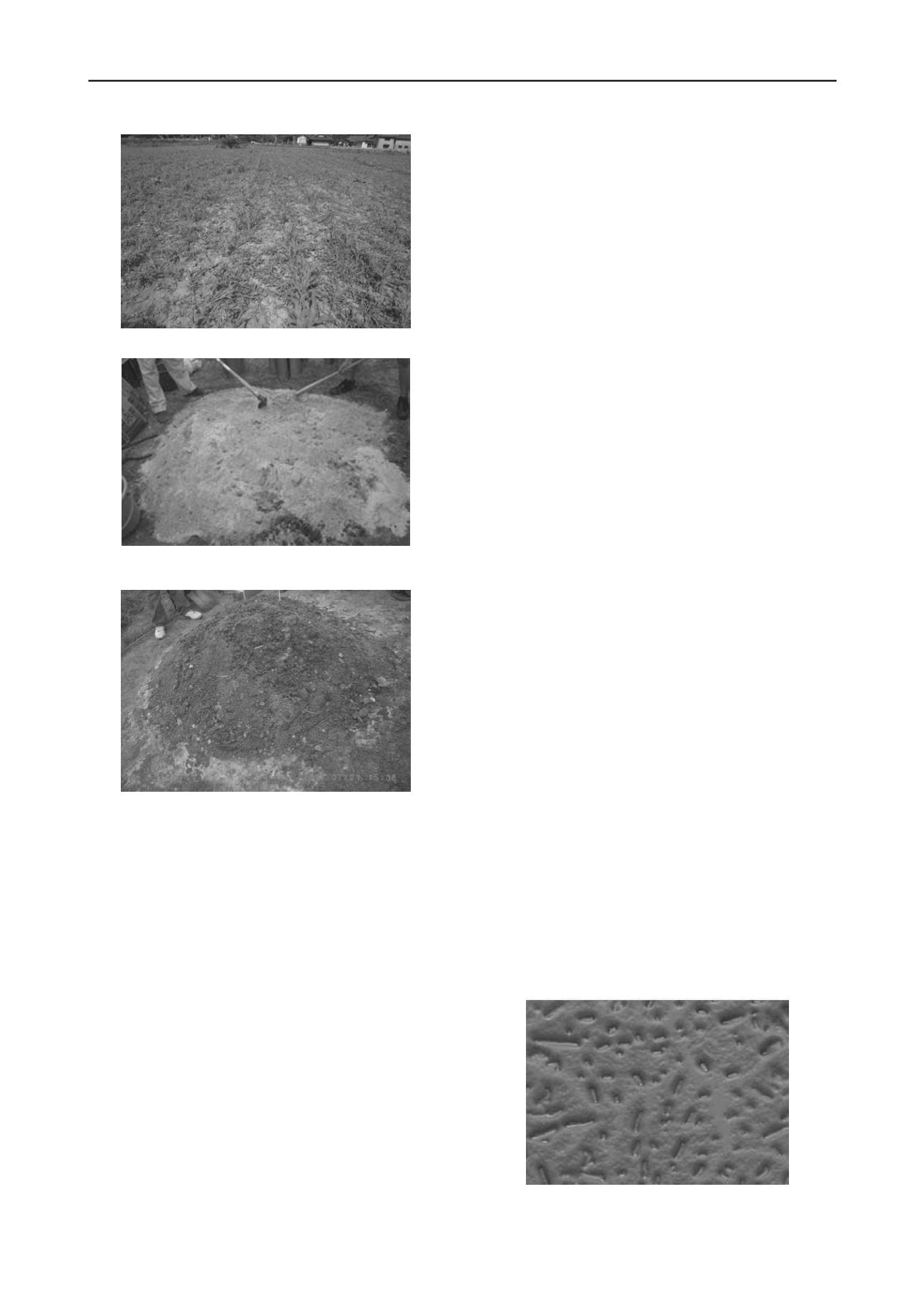
3059
Technical Committee 215 /
Comité technique 215
Figure 5. Growing corn at the agricultural land
Figure 6. Building up the compost by mixing rice bran, oil cakes, grinds
of fish bones and water
Figure 7. Processing of compost after 3 days
irrigation water. In this process, if export of the salt matches
with the import of the salt, then there will be accumulation of
salt in the field soil. However, it will take a long time and
efforts for such a design of the salinity removal method.
Another method is to establish salt tolerant plants for
reducing the salinity of soil biologically. Volunteers for
Rikuzentakata (Cheering group of Ganbappeshi Fukuoka)
discussed with the authors and proposed to plant sunflower and
corn at the saline lands.
They sent a large number of seeds to the local residents and
planted sunflower on 9.3 ha and corn on 0.6 ha on 5 June 2011
(Figs. 4 and 5). This method for salinity reduction may not be
sufficient for the vast areas.
In this study, an innovative idea was tested for reducing the
salt concentration from the agricultural soils. Mr. Usugami who
is a researcher of Fukushima produced special compost
containing salt tolerant bacteria or halo bacteria for many years
(Rural
Culture
Association
Japan
,
).
The
volume of the compost can be increased by mixing rice bran, oil
cakes, grinds of fish bones and water in a specific ratio. The
authors received 2 kg compost from him and increased up to
300 kg. After mixing each material, temperature of the compost
was increased to 48˚C for 2 days and turned over for aeration
(Figs. 6 and 7). The compost containing the halo bacteria was
made ready for application in the tsunami affected large areas of
Rikuzentakata for the purpose of reducing salinity of the
agricultural land.
For improving the agricultural land damaged by Tsunami,
the compost of 10 kg per 1000 m2 and the rice bran of 100 kg
per 1000 m2 are needed. The rice bran is nutrition for increasing
the halo bacteria/salt tolerance bacteria on site. The rice bran of
30 kg, oil cake of 10 kg, fish lees of 2 kg and water of 35 kg are
mixed with the original compost of 2.5 kg using mixer. It was
difficult to mix and turn over a large amount of the compost
several times, so that the compost was cured in a soil bag with
aeration effect as a simple method. Finally, 1 ton of the compost
was made and it was brought to Rikuzentakata city together
with 4 tons of the rice bran. These materials (compost and rice
bran) were disseminated at the agricultural land of 6 ha together
with oil-seed rape or rye as green manure crop.
Soil investigation at the site was performed on March 2012.
Due to the rail fall and vegetation of sunflower, the salt
concentration decreased gradually and the highest EC at the site
was 0.25 mS/cm on September 2011. The value of EC
decreased furthermore on March 2012. Therefore, it was
difficult to distinguish the effect of the compost with halo
bacteria/salt tolerance bacteria clearly. It is considered that the
compost contains necessary nutrition and the soil is improved.
4.2
Isolation of Salt Tolerant Bacteria/Halo bacteria
The sample was collected separately in sterile plastic sheets, and
brought to the laboratory for microbiological analysis. For
isolation and enumeration of microorganisms, soil sample was
serially diluted in sterile distilled water and plated on Luria–
Bertani agar (LB g/L:Peptone-10; yeast extract-5; Nacl-10;
Agar-15; pH-7.0-7.4) supplemented with 1% sodium
chloride
(NaCl) level. The plates were incubated at 30oC for 72 hours.
Colonies differing in morphological characteristics was isolated
in pure form and used for further studies. The screened Halo
bacteria was confirmed their growth in specific medium,
Mannitol salt agar (g/L: Enzymatic digest of Casein-5;
Enzymatic digest of animal tissue-5; Beef extract- 1; D-
Mannitol- 10; Sodium chloride- 75; Phenol red- 0.025 g; Agar-
15; pH- 7.4) is a selective and differential medium salt tolerance.
It contains 7.5% high salt concentration. The salt tolerant
bacteria grow in mannitol salt agar and ferment the mannitol, an
acidic by product is formed that will cause the phenol red turn
to yellow colour.
The salt tolerance was determined in LB agar supplemented
with NaCl. The growth was monitored after 72 hours incubation
at 30
o
C. Finally, six types of Halo bacteria were isolated from
the compost. At present, Halo bacteria exhibiting 15% salt
tolerance was determined in LB agar. Figure 8 shows
microscopic view of salt tolerance bacteria isolated from the
compost. Figure 9 shows the result of salt tolerance test on the
compost. The salt tolerant bacteria exhibited salt tolerance
ranged from 16-18 % in LB agar. Optimum growth test of
bacterial was not conducted, so that the salt tolerance bacteria
are not identified as Halo bacteria herein.
Figure 8. Microscopic view of salt tolerance bacteria isolated from the
compost


